9 great ways to start strength training at home
Build up your muscles in your living room with these smart picks.
 Credit:
Bret Contreras / Cap
Credit:
Bret Contreras / Cap
Products are chosen independently by our editors. Purchases made through our links may earn us a commission.
There’s a lot you can do to strengthen your body and tone up with absolutely zero equipment. Think: push-ups, step-ups, body-weight squats, and hollow-body holds.
But, as I tell my training clients, sometimes, that’s not always enough to hit your training goals. And if weight-moving workouts are your favorite way to exercise (or strength- or muscle-building is one of your goals), investing in your at-home resistance training setup will work wonders for your physical health as well as mental wellbeing.
To outfit your home weight room and build the strength you want, check out our comprehensive guide to nine types of resistance-training equipment, including what I recommend for my clients and the strength equipment I have in my own at-home gym.
1. Pull-up and equalizer bars to maximize your bodyweight work
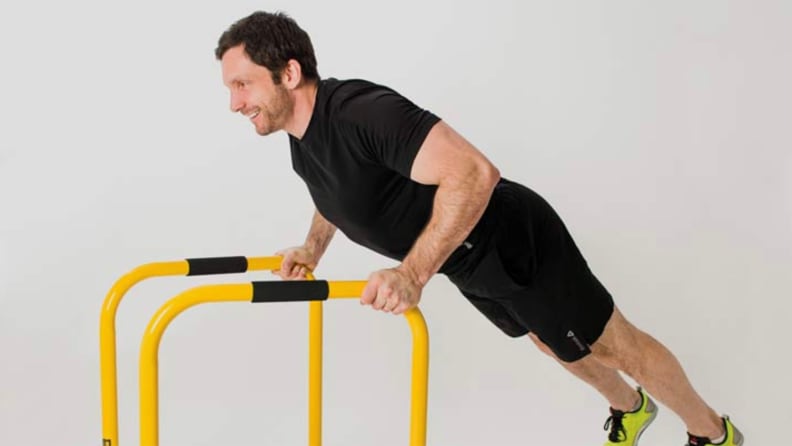
Adding some elevation to your push-ups can make a big difference.
Nope, not all bodyweight training is gear-free. That’s especially true for any pulling, or back-strengthening, work. After all, it’s basically impossible to perform pull-ups or bodyweight rows without something to hold onto and, well, pull against. That’s where pull-up bars and equalizer bars, their freestanding cousin, come in handy.
Considerations: Both types of bars are great for strengthening the back and are natural options for people who like full-body bodyweight training. However, pull-up bars can be one-trick ponies. If you get one, look for options that include multiple grip options. Otherwise, equalizer bars allow you to do more exercises, including rows, L-sits, push-ups, and dips—without damaging the doorway or wall.
Products picks: If you’re in the market for a solo pull-up bar, I recommend a wall-mounted one with multiple handholds like the Onetwofit. While doorway and tension bars can also work, mounting the bar into the studs of your wall provides an extra level of security. Meanwhile, Lebert Fitness Equalizer Bars are the gold-standard for free-standing bars, and many of my clients love them.
- Get the Onetwofit Pull-up Bar from Amazon for $93.98
- Get Lebert Equalizer Bars from Power Systems for $100.09
2. Resistance bands to save space while you build muscle
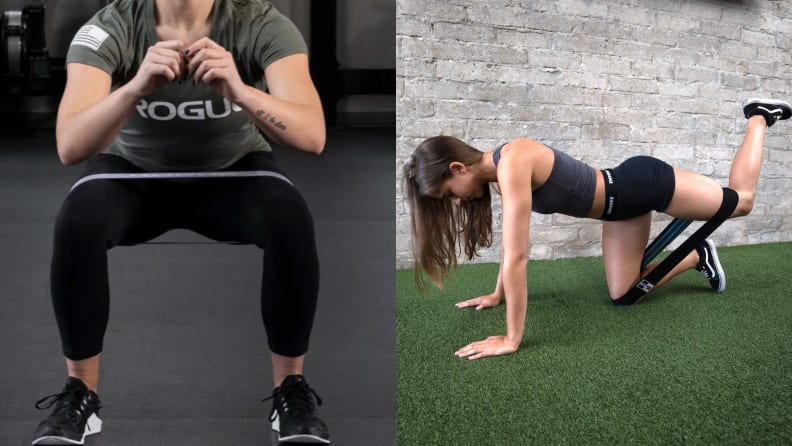
Resistance loops can be small, but they add a lot to your workout.
Resistance bands are easy to store and easy to use, which makes them ideal for at-home exercise, especially when you have limited space. They’re unique from free weights in that they apply more resistance to your muscles the further you move into a given exercise (i.e., the more you stretch them).
Considerations: Resistance bands come in multiple varieties. Some are tubes with two ends and handles at each one, while some are built into long loops about four feet across or small ones a foot in diameter. Handled options tend to be the most comfortable for resistance-band newbies, while long, looped bands are the most versatile option, and those mini bands are ideal for hip exercises. No matter what kind you go for, choosing durable options is important to reduce the risk of fraying or breaking.
Product picks: The brand Rogue makes multiple kinds of resistance bands and is my first stop for finding versatile, well-made ones. The NT Loop and Glute Loop are two cloth-based options that I always have on hand, and are arguably the most durable bands you can use.
- Shop Rogue Fitness Resistance Bands starting at $6
- Get the NT Loop Combo Pack for $89
- Get the Glute Loop from Bret Contreras for $20
3. Dumbbells for multipurpose strength training
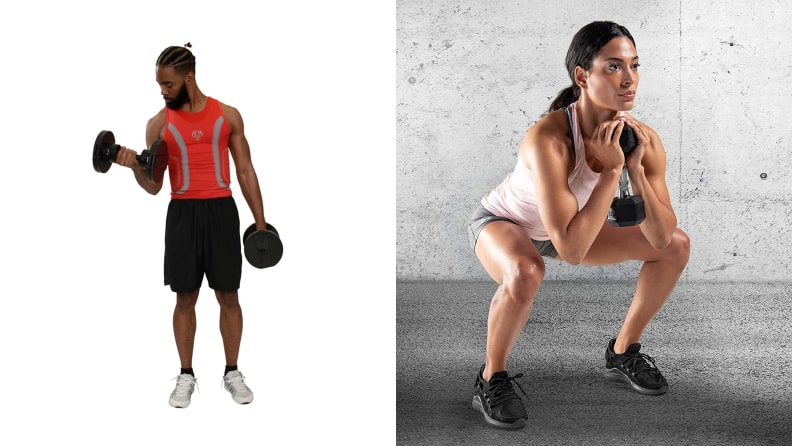
Whether you go adjustable or classic, dumbbells are a great way to train.
There’s a reason why dumbbells are a mainstay in most weight rooms. They excel as free weights, allowing you to lift them up (against gravity) to train and strengthen up in all three dimensions with an endless array of both compound and isolation exercises. They’re also relatively space efficient, and have a good value for their price.
Considerations: Give serious thought to the poundage you'll actually use, as it’s common for people to waste money on full sets that contain weights they rarely—if ever—lift. On the other hand, only getting one set in one weight will do you a disservice, as of course some of your muscles are bigger and stronger than others. Purchasing a few choice dumbbell pairs (in the range of, say, 5 pounds to 30 pounds), or even a set of adjustable-weight dumbbells, which go up to 50 or more pounds each, can be smart choices for people who are on a budget or short on space. Just know that with adjustable-weight sets, the total size of each dumbbell may be larger than you’d find with single weights, which can slightly alter exercise setups and movement patterns.
Product picks: For individual dumbbells, check out hex rubber options like those from Cap Barbell. With the angled ends and soft casing, they won’t roll or clang around. You’ll find the NordicTrack 55 Lb. Select-A-Weight Dumbbell Set in my at-home gym. Other people like Bowflex’s SelectTech Dumbbells and Core Home Fitness’ adjustable dumbbells. The brand Powerblock also makes multiple sets. Just be aware that, due to the coronavirus pandemic and subsequent popularity of at-home fitness, most adjustable weights are tough to find—if you can’t get a set now, bookmark your favorite pair so you can check up on them to see when they’re back in stock.
- Shop CAP Coated Dumbbell Weights from Amazon starting at $39
- Get 55 Lb. Select-A-Weight Dumbbell Set from NordicTrack for $599
- Get SelectTech 552 Dumbbells from Bowflex for $349
- Get Adjustable Dumbbells from Core Home Fitness for $349.99
- Shop PowerBlock Dumbbells starting at $159
4. A bench to change the angle at which you work your muscles
When performing seated or flat-on-your-back exercises, benches provide stability while, in some cases, increasing your available range of motion. They’re a must for anyone who wants to get the most out of their free-weight setup.
Considerations: Here, the least expensive option is a flat bench, but it’s not going to provide the versatility of an incline or seated bench. In my opinion, it makes the most sense to get a single adjustable one. Look for a decent amount of durable, tear-proof padding and, for convenience’s sake, wheels.
It’s also important to think through the best bench height for your own body height. Bench pads that sit 15 to 17 inches off the floor are ideal for folks 5-foot-6 and under, while 17 to 20 inches are best suited toward taller folks. Another tip to find your best bench height is to measure your shin height: You want the center of your knees to be just above the top of your bench.
Product pick: The Bowflex SelectTech Adjustable 5.1S stowable bench is consistently rated one of the best around, with adjustable-height feet, wheels, multiple incline and decline options, and can fold down and be stored vertically, reducing its footprint by 50 percent.
Get the SelectTech Adjustable 5.1S Stowable Bench from Bowflex for $329
5. Kettlebells to add power to your movements
If you already know and love kettlebells, there’s no reason to not include them in your at-home workout stash. They allow you to perform dynamic exercises such as kettlebell swings and windmills, as well as traditional strength moves like squats, deadlifts, rows, and overhead presses.
Considerations: While you can buy a whole set, you can get a great workout with even just one kettlebell—you don’t even need a pair. If you’re buying just one bell, opt for a medium-weight option. Otherwise, consider getting one light, medium, and heavy option so that you can use them for both the widest range of exercises. For the average relatively fit person, 10 to 15 pounds will be light (for upper body workouts), 20 to 40 pounds will be medium (best for things like swings), and 40 to 60 pounds will be about the heaviest anyone wants to go for deadlifts or heavy squats. Adjustable-weight kettlebells are also an option.
Product picks: Metrixx Elite E-coat Kettlebells are consistently some of the highest rated bells for at-home use. Meanwhile, Powerblock makes a great adjustable kettlebell with a slim design that won’t throw off your regular movements.
- Get Metrixx Elite E-Coat Kettlebells from Kettlebells USA starting at $154.99
- Get the Adjustable Kettlebell from Powerblock for $159
6. Suspension trainers to maximize your body-weight training
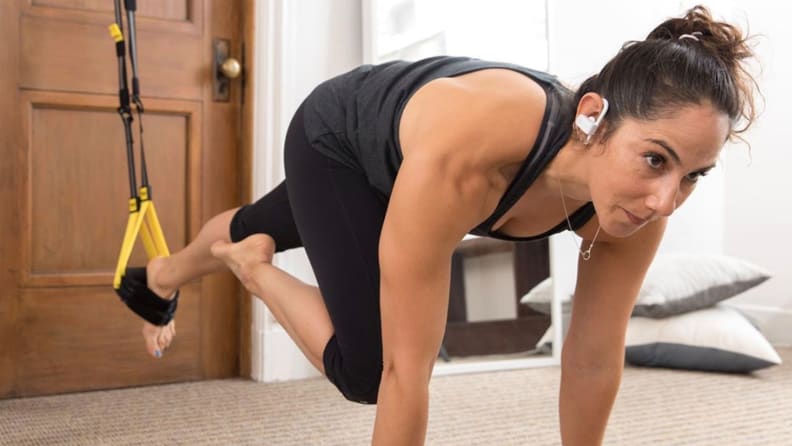
If you're looking to get into suspension training, your first stop should be TRX.
Suspension trainers (a.k.a. the yellow-and-black TRX straps you’ve seen at gyms) are another good space-saving option, being composed of just two handled straps that you affix to a point overhead. They provide the pull-up and row benefits of pull-up and chin-up bars, while also allowing you to increase the difficulty of planks, push-ups, hamstring curls, and progress into next-level moves like pistol squats and handstands. They can be a really fun way to manipulate your own body weight as a resistance-training tool.
Considerations: Suspension trainers themselves take up close to zero space, but when using them, you’ll need room to position your body into all sorts of moves. So, before you buy, make sure you have enough space to work out under and around a door that you can securely close. Alternatively, you can buy a wall anchor to secure the system in other locations.
Product picks: Is there even a question about this one? The TRX is where it’s at. I use it myself and recommend it for my clients. That said, TRX makes multiple systems designed for at-home, commercial, or tactical use. The TRX Home 2, which has everything 99 percent of at-home gyms need out of a suspension system, is a great choice.
7. Cable machines to train like you’re at the gym
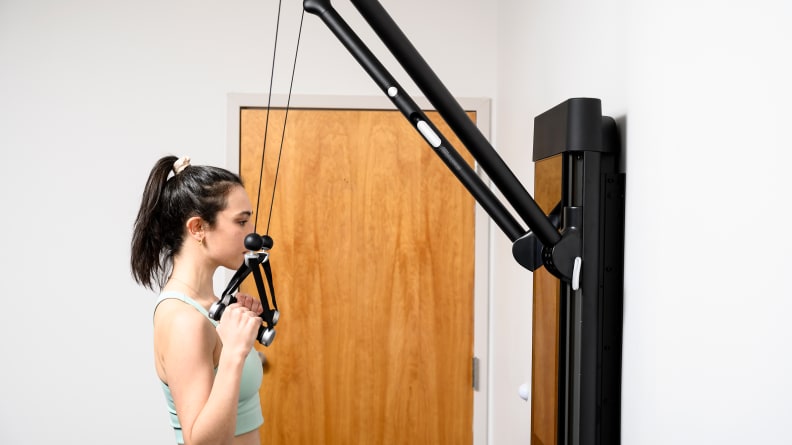
Cable machines like Tonal can help you get a serious weight-training setup in your own house.
Cable machines are awesome because they apply consistent resistance to your muscles to improve strength gains through each joint’s total range of motion. Plus, they allow your body to build muscle by fighting something other than gravity (i.e., the main force you’re overcoming with traditional weights that you lift).
Considerations: As versatile and beneficial as they are, cable machines often come with a large footprint and an even bigger price tag. So, evaluate your options, budget, and space requirements. Traditional cable machines are built with weight stacks, with the exerciser choosing weights with the slide of a pin. However, a new breed of at-home options use digital electromagnetic resistance, meaning they take up less space and look more attractive, but may not allow you to lift quite as heavy as you would with metal or serve as the most durable option.
Product picks: The Tonal digital cable machine is la crème de la crème of interactive cable machines, providing up to 200 pounds of resistance and AI to evaluate, coach, and change weights in real time. For an old-school approach, dual cable cross machines like the Freemotion Genesis Dual-Cable Cross allow the most versatility and max weights loads of 240 pounds.
8. Barbell setups to start powerlifting
Barbells open you up to lift more weight than is possible with dumbbells or kettlebells, and deserve a spot on the wish list of anyone who’s into Olympic weightlifting, powerlifting, or CrossFit.
Considerations: Space is often a limiting factor when it comes to at-home barbell set-ups, so consider how much floor—as well as vertical—space you have for the rack and for moving around it. The amount of real estate you have available will be a determining factor as to whether you want to go with a simple squat rack or a full power rack, which is like a cage and offers more versatility while taking up a lot more room. When choosing weights, rubber weight plates, as opposed to metal ones, are more shock-absorbing to help keep things quiet. They also position the barbell at the optimal height for deadlifts, hip-thrusts, and other ground-up exercises.
Product picks: The squat stands, power racks, barbells, and weight plates from Eleiko and Rogue are, as far as I’m concerned, unparalleled. They’re the gold standard, providing the ultimate in quality, durability, and usability. If you’re operating on a tight budget or space requirement, but still want the best quality available, the Eleiko Light Squat Stand and Rogue 90” Slim Rack are solid options. For more versatility, a power rack with a self-stabilizing base, such as its Flat Foot Monster Lite Rack, is a good value for at-home use. Both companies also make barbells, weight plates, and weight clips, as well as lifting platforms.
- Get the Eleiko Light Squat Stand from Strengthwear for $477
- Get the 90-Inch Slim Rack from Rogue for $325
- Get the RML-390F Flat Foot Monster Lite Rack from Rogue for $795
9. Functional gear to mix up your workouts
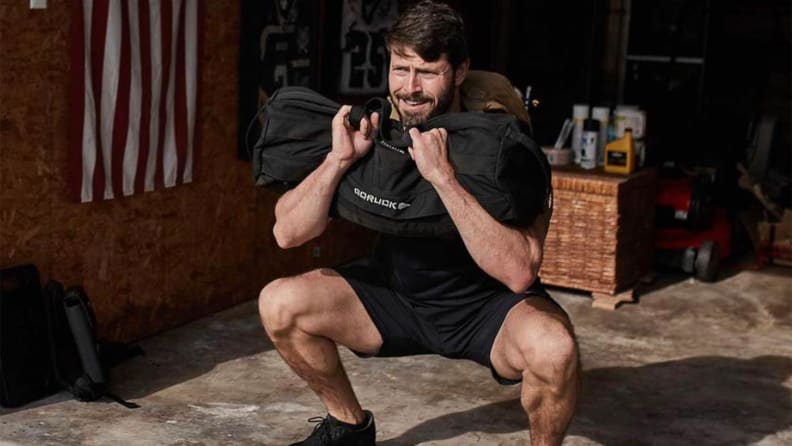
Put the "fun" in "function" with some sandbags.
To my mind, all exercise is functional (in the sense that if done correctly, you will achieve the goals you want). But if you’re one for sandbags, sleds, and medicine balls, you’ll be happy to know these aren’t limited to professional gyms or CrossFit boxes.
Considerations: Functional gear tends to provide little versatility for the cost involved, but if you’re training for obstacle course races, max power, or overall athleticism, they can be valuable additions to dumbbells and a barbell. When it comes to sleds in particular, keep in mind that they require a lot of space to move—either outdoors or in (though preferably on rubber, turf, or low-pile carpet).
Product picks: With sandbags, prioritize hardiness, tough straps, and leak-resistant design; GoRuck provides multiple different weight options. Titan makes an awesome sled that has handles for all the pushing and pulling you’d want to do. When it comes to balls, Spartan—yes, of the famed obstacle races—makes super durable wall balls in multiple weights.


